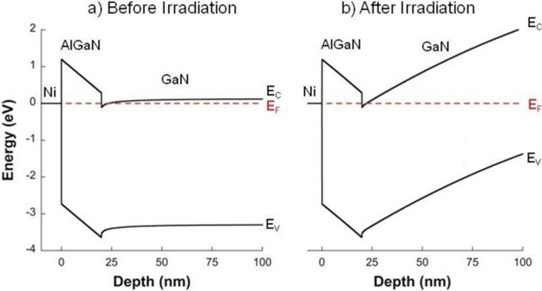- News
15 July 2016
NRL explains radiation tolerance of AlGaN/GaN HEMTs versus AlGaAs/GaAs HEMTs
When it comes to putting technology into space, size and mass are prime considerations. High-power gallium nitride (GaN)-based high-electron-mobility transistors (HEMTs) are appealing in this regard because they have the potential to replace bulkier, less efficient transistors, and are also more tolerant of the harsh radiation environment of space. Compared to similar aluminum gallium arsenide/gallium arsenide (AlGaAs/GaAs) HEMTs, the GaN-based HEMTs are ten times more tolerant of radiation-induced displacement damage.
Until recently, the cause for this phenomenon could only be guessed. Was the gallium nitride material system itself so inherently disordered that adding more defects had scant effect? Or did the strong binding of gallium and nitrogen atoms to their lattice sites render the atoms more difficult to displace? The answer, according to scientists at the US Naval Research Laboratory (NRL) in Washington DC, is none of the above.
Examining radiation response
In a recent article 'On the Radiation Tolerance of AlGaN/GaN HEMTs' (in the open-access ECS Journal of Solid State Science and Technology (2016) vol5, issue7, pQ208), the NRL team states that, by studying the effect of proton irradiation on GaN-based HEMTs with a wide range of initial threading dislocation defectiveness, they found that the pre-irradiation material quality had no effect on radiation response.

Picture: Schematic band diagram of GaN/AlGaN HEMT before and after irradiation by a fluence of 6×1014 2MeV H+/cm2, as calculated using BANDENG. The values of (Nd − Na) were (a) 2×1016cm−3 and (b) −2.55×1016cm−3, and were chosen to reproduce the experimentally determined sheet carrier density.
Additionally, the team discovered that the order-of-magnitude difference in radiation tolerance between GaAs- and GaN-based HEMTs is much too large to be explained by differences in binding energy. Instead, they noticed that radiation-induced disorder causes the carrier mobility to decrease and the scattering rate to increase as expected, but the carrier concentration remains significantly less affected than it should be.
Applications in space exploration
Because of their relative radiation hardness, GaAs- and GaN-based HEMTs are desirable for space application, such as the Juno Spacecraft, which on 4 July entered orbit around Jupiter (a planet that scientists still know very little about), which generates extreme levels of radiation. Without the appropriate technology, Jupiter's radiation levels could destroy the sensitive electronics in the satellite upon approaching the planet. Better understanding of why GaAs- and GaN-based HEMTs are more tolerant of radiation could ultimately accelerate innovation and bolster projects where radiation levels prove to be barriers.
Unexpected answers
The explanation for this novel discovery turns out to be rather elegant. In GaN-based HEMTs, a piezoelectric field forms at the AlGaN/GaN interface due to lattice strain. The field gives rise to a two-dimensional electron gas (2DEG) by which carriers travel across the transistor from source to drain. It also provides an electrically attractive environment that causes carriers that are scattered out of the 2DEG by radiation-induced defects to be reinjected. In this way, the scattering rate can increase and the mobility can decrease without greatly affecting the 2DEG carrier density. In other words, it is the internal structure itself that renders AlGaN/GaN HEMTs rad-hard.
"Gallium nitride is such a complicated system – not like gallium arsenide at all," says Bradley Weaver, co-author of the study. "We struggled for four years to figure out why it's so rad-hard, expecting a complicated solution. But the answer turned out to be really simple."
http://jss.ecsdl.org/content/5/7/


